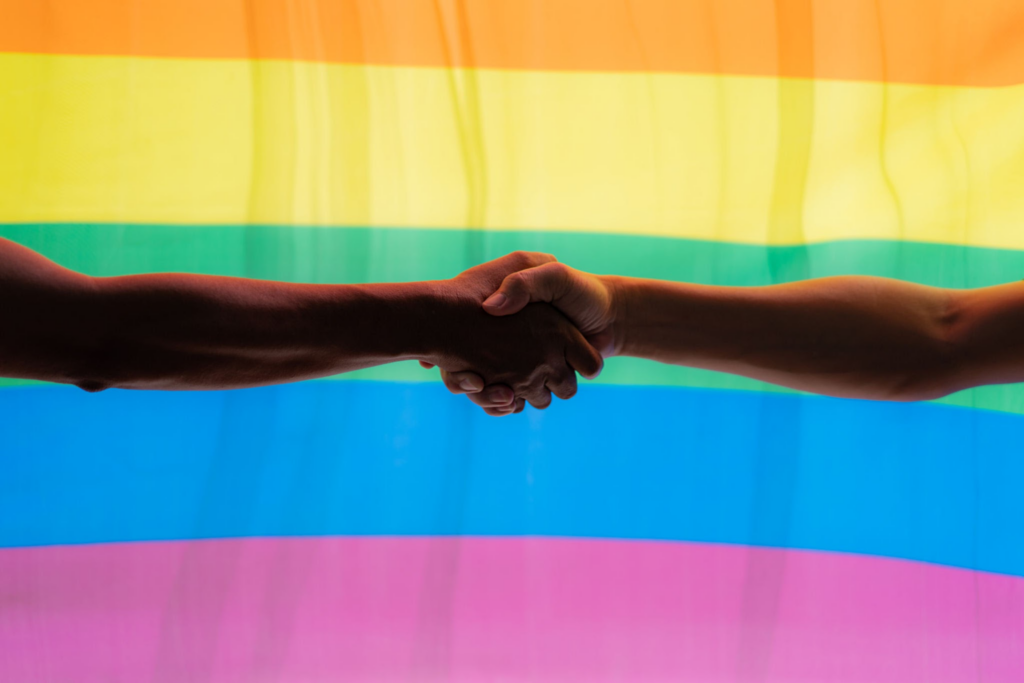Have you ever stumbled trying to refer to someone and wished there were more options than just “he” or “she”? Enter the world of LGBT pronouns, a spectrum of language tools that empower us to create a more inclusive and respectful conversation. But with so many variations, understanding LGBT pronouns can feel like deciphering a secret code. Don’t worry, this guide will be your decoder ring, unveiling the power of LGBT pronouns and ensuring you confidently navigate the landscape of identity.

LGBT Pronouns in the Rainbow: Navigating Gender Expression in the LGBT Community
Have you ever fumbled over someone’s pronouns during a conversation? Let’s face it, the world of pronouns can feel a bit like a secret language, especially when it comes to navigating gender identity within the LGBT community. But fear not, fellow travelers! This guide is your roadmap to understanding LGBT pronouns, shattering misconceptions, and fostering a more inclusive environment for everyone.
Setting the Stage: Why Pronouns Matter
Imagine this: you’re having a coffee date with a new friend, someone you genuinely connect with. As the conversation flows, you want to refer to them, but you hesitate. “He,” “she,” or something else entirely? It might seem like a minor detail, but pronouns are the cornerstones of our communication. They allow us to talk about someone without constantly repeating their name. But more importantly, LGBT pronouns act as powerful tools for validating someone’s gender identity and creating a space of respect.
Defining Pronouns: Beyond He and She
Remember those grammar lessons from school? Pronouns are words that take the place of nouns. They can be singular (I, you, he, she, it) or plural (we, they, you). But the traditional binary of “he” for men and “she” for women doesn’t quite encompass the beautiful spectrum of gender identities. This is where LGBT pronouns come in, offering a more inclusive way to refer to someone.
Understanding Pronouns: Pronouns 101: A Crash Course
Let’s delve a little deeper into the wonderful world of pronouns. Here’s a quick breakdown:
- Subject Pronouns: These pronouns perform the action in a sentence (e.g., I, you, he, she, they).
- Object Pronouns: These pronouns receive the action (e.g., me, you, him, her, them).
- Possessive Pronouns: These pronouns show ownership (e.g., mine, yours, his, hers, theirs).
- Reflexive Pronouns: These pronouns refer back to the subject (e.g., myself, yourself, herself, himself, itself, ourselves, yourselves, themselves).
Traditional Pronouns vs. Gender-Neutral Pronouns
The traditional “he/him/his” and “she/her/hers” pronouns have long been the norm. However, for many individuals within the LGBT community, these pronouns don’t align with their gender identity. This is where LGBT pronouns like “they/them/their” or “ze/hir/zir” come into play. These gender-neutral pronouns offer a way to refer to someone without assuming their gender.
Exploring Pronoun Variations: They/Them, Ze/Hir, and Beyond
The world of LGBT pronouns is vast and ever-evolving. Here are some of the most common variations you might encounter:
- They/Them/Their: This is the most widely used set of gender-neutral pronouns. It’s perfect for situations where someone’s gender identity is unknown or non-binary.
- Ze/Hir/Zir: This pronoun set offers a completely gender-neutral alternative.
- Sie/Hir (singular they) and Sie/Them (plural they): These pronouns are gaining traction in some communities and can be used similarly to “they/them.”
It’s important to remember that pronoun preference is individual. The best way to ensure you’re using the correct pronouns is to ask!
Pronouns in the LGBT Community: Breaking the Binary
Gender identity is a spectrum, not a binary. Many people within the LGBT community identify outside the traditional categories of “man” or “woman.” This is where LGBT pronouns become crucial. By using someone’s preferred pronouns, we acknowledge and respect their authentic self.
The Fluidity of Pronouns: Embracing Change
Sometimes, a person’s pronoun preference might change over time. This is perfectly normal! Just like our identities can evolve, so too can our pronouns. The key is to be flexible and respectful of these changes.
Pronoun Preferences: Respecting Individuality
Imagine meeting Alex for the first time at a club. As you chat, Alex mentions their pronouns are they/them. This simple act of sharing pronouns opens the door to a more inclusive conversation. Here are some tips for respecting pronoun preferences:
- Normalize asking and sharing pronouns. When you introduce yourself, consider including your pronouns (e.g., “Hi, I’m Sarah, she/her pronouns”). This encourages others to do the same.
- Be an active listener. When someone shares their pronouns, pay attention and use them consistently throughout the conversation.
- Mistakes happen, don’t sweat it! If you accidentally use the wrong pronoun, simply apologize and correct yourself. A sincere “I’m so sorry, I meant they/them” goes a long way.
- Focus on the intent, not the error. We all make mistakes. The important thing is to show respect and willingness to learn.

Navigating Pronouns in Society
LGBT pronouns are making their way into all aspects of our lives, and that’s a beautiful thing! Let’s explore how pronouns are playing a role in different social spheres.
Pronouns in Pop Culture: From TV Shows to Social Media
Pop culture is a powerful force in shaping language and social norms. Thankfully, LGBT pronouns are gaining more visibility in television shows, movies, and even social media. From characters like Robin in “Stranger Things” who uses they/them pronouns to celebrities like Miley Cyrus who identifies with she/they pronouns, these representations are fostering a more inclusive understanding of gender identity.
Pronouns in the Workplace: Promoting Inclusivity
The workplace should be a space where everyone feels valued and respected. Here’s how LGBT pronouns can contribute to a more inclusive work environment:
- Include pronoun fields in applications and onboarding materials. This allows individuals to share their pronouns comfortably.
- Normalize pronoun usage in meetings and introductions. Encourage everyone to share their pronouns.
- Implement pronoun training for employees. This helps educate everyone about LGBT pronouns and their importance.
Pronouns in Education: Fostering Acceptance
Schools play a vital role in shaping young minds. By incorporating LGBT pronouns into the curriculum and fostering open conversations about gender identity, we can create a more accepting and inclusive learning environment for all students.
Here are some ways to achieve this:
- Create a safe space for students to explore gender identity. This can be done through classroom discussions, guest speakers, or LGBTQ+ clubs.
- Educate teachers and staff about LGBT pronouns and their importance.
- Incorporate inclusive language into textbooks and learning materials. This includes using gender-neutral language and featuring diverse gender identities.
Stay tuned for the next section where we’ll delve into the challenges and misconceptions surrounding LGBT pronouns, explore the evolution of pronoun usage throughout history, and celebrate the power of pronoun diversity!

Pronouns in the Rainbow
Challenges and Misconceptions:
The journey towards pronoun inclusivity isn’t always smooth sailing. Let’s tackle some common challenges and misconceptions surrounding LGBT pronouns.
Pronoun Pitfalls: Common Mistakes and How to Avoid Them
- The Singular “They” Trap: There’s a misconception that “they” can’t be used as a singular pronoun. But guess what? It’s grammatically correct!
- Mind Reading Mishap: Don’t assume someone’s pronouns based on their appearance or name. The best way to avoid this pitfall? Ask!
- The “Outing” Anxiety: Some worry that asking about pronouns might “out” someone who isn’t ready to share their identity publicly. Remember, asking pronouns is about creating a space of respect, not forcing someone to disclose their gender identity.
Deconstructing Pronoun Myths: Separating Fact from Fiction
- Myth #1: Using gender-neutral pronouns creates confusion. Reality check: Studies show that people quickly adapt to using new pronouns. In fact, using the correct pronouns can reduce anxiety and improve well-being for those who identify outside the gender binary.
- Myth #2: Gender-neutral pronouns are a fad. Not quite! The use of gender-neutral pronouns has roots in historical and cultural contexts. We’ll explore this more in the next section.
- Myth #3: There’s a “political agenda” behind using LGBT pronouns. It’s not about politics; it’s about respect. Using someone’s preferred pronouns acknowledges their identity and creates a more inclusive world.
The Evolution of Pronouns: A Historical Journey
- Historical Perspectives: How Pronoun Usage Has Evolved
Language is a living thing, constantly evolving. Pronouns are no exception! Did you know that singular “they” has been used in the English language for centuries? Geoffrey Chaucer, the famous writer, used “they” to refer to someone of unknown gender back in the 14th century!
- Trends in Pronoun Adoption: Shaping Language for the Future
The internet and social media have played a significant role in raising awareness about LGBT pronouns. Online communities have created spaces for individuals to explore gender identity and share their pronoun preferences. This online activism is translating into the real world, with more and more people embracing pronoun diversity.
Celebrating Pronoun Diversity:
Pronoun Pride: Embracing Diversity and Inclusivity
Imagine a world where everyone feels comfortable expressing their authentic selves. That’s the power of pronoun diversity! By using LGBT pronouns, we celebrate the beautiful spectrum of gender identities and create a more inclusive environment for everyone.
Pronouns as Empowerment: Affirming Identity and Self-Expression
For many within the LGBT community, having their pronouns acknowledged is a powerful form of validation. It’s a way of saying, “I see you, I respect you, and I value your identity.” This simple act of using someone’s preferred pronouns can have a profound impact on their self-esteem and sense of belonging.

Conclusion: Reflecting on Pronouns: Why They Matter More Than Ever
In a world that often tries to fit people into neat boxes, LGBT pronouns offer a powerful tool for breaking free from binary limitations. By embracing pronoun diversity, we create a more inclusive and respectful space for everyone.
Moving Forward: Championing Pronoun Awareness and Acceptance
Language is a powerful tool, and it’s up to us to use it inclusively. Here’s how you can be a champion for pronoun awareness and acceptance:
- Educate yourself and others! There are countless resources available online and in libraries to learn more about LGBT pronouns and gender identity.
- Be an advocate for pronoun inclusion. Encourage your friends, family, and colleagues to embrace pronoun diversity.
- Lead by example! Normalize asking and sharing pronouns in your everyday interactions.
Remember, even small gestures can make a big difference. By using LGBT pronouns respectfully and promoting pronoun awareness, we can create a world where everyone feels valued and seen.
Feminizator.com is a website that believes that femininity is a colorful universe. Here, you won’t find rigid definitions or worn-out stereotypes about femininity. Instead, we celebrate a vibrant spectrum with all the complexity, power and joy of being “it”. Every day, we dive into the multifaceted world of femininity. We explore topics such as inner strength, creative expression, conscious living and global perspectives. We also embrace LGBT+ and transgender people and show them different ways of being feminine. We are here to empower you to embrace your femininity, own your own story and blossom into the best version of yourself. Welcome to Feminizator. Welcome to yourself.
FAQs (Frequently Asked Questions):
1. What are gender-neutral pronouns, and why are they important?
Gender-neutral pronouns like “they/them” or “ze/hir” allow us to refer to someone without assuming their gender identity. They are important because they create a more inclusive space for people who identify outside the gender binary.
2. How can I respectfully ask someone about their pronouns?
The best way to ask about someone’s pronouns is in a casual and inclusive way. Here are some examples:
- “Hi [name], I’m Sarah, she/her pronouns. What are yours?”
- “Would you mind sharing your pronouns?”
- 3. What should I do if I make a mistake with someone’s pronouns?
Everyone makes mistakes! The most important thing is to apologize sincerely and correct yourself moving forward. Here’s what you can say:
- “I’m so sorry, I meant they/them.”
- “Excuse me, could you please remind me of your pronouns?”
- “Oh no, I apologize for using the wrong pronoun. Thank you for correcting me.”
4. Are there any pronouns specific to the LGBT community?
While some pronoun sets like ze/hir are more commonly used within the LGBT community, anyone can choose to use gender-neutral pronouns regardless of their sexual orientation or gender identity.
5. How can I incorporate pronoun awareness into my daily life and language?
There are many ways to integrate pronoun awareness into your daily routine:
- Include your pronouns in your email signature, social media bios, and introductions.
- When talking about someone whose pronouns you don’t know, use gender-neutral language (e.g., “they went to the store” instead of “he or she went to the store”).
- Correct others (kindly!) if they misgender someone.
- Advocate for pronoun inclusion in your workplace, school, or community organizations.
By making small changes in your everyday language, you can contribute to a more inclusive and respectful environment for everyone.
Remember, embracing pronoun diversity is a journey, not a destination. There will be bumps along the road, but with a little effort and a lot of kindness, we can create a world where everyone feels comfortable expressing their true selves.


